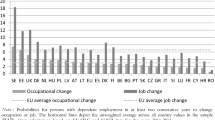Summary
The study introduces a distinction between two types of labor mobility. Direct job to job changes (which are assumed to be voluntary) and job changes after experiencing an unemployment spell (assumed to be involuntary). Exploiting the close relationship between those two phenomena we adopt a bivariate regression framework for our empirical analysis of data on male individuals in the German labor market. To account for the non-negative and discrete nature of the two counts of job changes in a ten year interval a new econometric model is proposed: the bivariate Poisson regression proves to be superior to the univariate specification. Further, the empirical content of distinguishing between two types of mobility is subject to a test, and, in fact, supported by the data: The hypothesis that both measures are observationally equivalent can be rejected.
Similar content being viewed by others
References
Börsch-Supan A (1990) Education and its double-edged impact on mobility.Economics-of-Education-Review 9(1):39–53
Cameron AC, Trivedi PK (1986) Econometric models based on count data: comparisons and applications of some estimators and tests.Journal of Applied Econometrics 1:29–53
Feller, W (1968)An introduction to probability theory and its application Vol. I. New York: Wiley
Gilbert CL (1979) Econometric models for discrete (integer valued) economic processes. In: EG Charatsis (ed.)Selected Papers on contemporary econometric problems. The Athens School of Economics and Business Science
Gourieroux C (1989)Econométrie des variables qualitatives. Paris: Economica
Gourieroux C, Monfort A, Trognon A (1984a) Pseudo maximum likelihood methods: Theory.Econometrica 52:681–700
Gourieroux C, Monfort A, Trognon A (1984b) Pseudo maximum likelihood methods: Applications to Poisson models.Econometrica 52:701–720
Johnson NL, Kotz S (1969)Distributions in Statistics: Discrete Distributions. New York: John Wiley & Sons
Jovanovic B (1984) Matching, turnover, and unemployment.Journal of Political Economy 92(1): 108–122
King G (1989) A seemingly unrelated Poisson regression model.Sociological Methods and Research
Kocherlakota S, Kocherlakota K (1992)Bivariate Discrete Distributions. New York: Marcel Dekker
McCullagh P, Nelder J (1989)Generalized linear models. London: Chapman and Hall
McLaughlin KJ (1991) A theory of quits and layoffs with efficient turnover.Journal of Political Economy 99(1):1–29
Mincer J, Jovanovic B (1981) Labor mobility and wages. In: S. Rosen (ed.)Studies in labor markets. Chicago: The University of Chicago Press
Topel RH, Ward MP (1992) Job mobility and the careers of young men.Quarterly Journal of Economics 106(2):439–479
Author information
Authors and Affiliations
Additional information
Valuable comments by Gerd Ronning, Christoph M. Schmidt as well as the editor and two anonymous referees are gratefully acknowledged.
Rights and permissions
About this article
Cite this article
Jung, R.C., Winkelmann, R. Two aspects of labor mobility: A bivariate Poisson regression approach. Empirical Economics 18, 543–556 (1993). https://doi.org/10.1007/BF01176203
Received:
Revised:
Issue Date:
DOI: https://doi.org/10.1007/BF01176203




